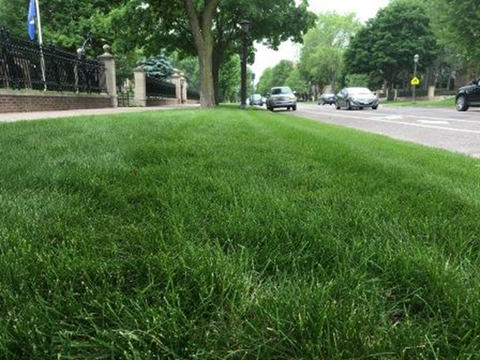Turfgrass is an important component of urban and rural lawns and landscapes.
A healthy lawn can:
- Prevent erosion by wind and water
- Improve flood control
- Help the breakdown of organic chemicals
- Reduce noise
- Provide wildlife habitat
- Create a cooling effect during warm weather
- Add visual appeal
Turfgrass improves water quality
Turfgrasses are some of the most effective ground covers for sites with steep slopes to prevent erosion, saturated soil, and severely compacted soil.
- They protect frozen ground over winter.
- When established, they allow water to better infiltrate into the soil.
- Cool season grasses have a dense network of roots that help trap and remove pollutants from water as it moves through the soil.
- Runoff water moves slower, so it cannot carry as much sediment or other soil particles as faster-moving water.
Turfgrass improves soil
The periodic shedding of grass roots, stems and leaves is a normal part of the annual growth cycle of cool season grasses and adds large amounts of helpful organic matter to the soil over time.
This organic material creates a healthier, thick and vigorous lawn by improving soil structure.
It contributes to
- Improved water infiltration
- Increased rooting depth allowing for greater access to soil water and nutrients
- Improved microbial activity
Turfgrass cools the air
Lawns, trees, and shrubs play an important role in reducing air temperatures by providing shade and evaporation through evapotranspiration, which is the process the process of water evaporating off of plants.
Temperature reduction can range from 7 to 14 degrees and can curb summer air conditioning costs. One estimate suggests that planting lawns and other landscape plants could reduce total U.S. air conditioning energy requirements by 25 percent.
Lawns also provide cooler places for summer recreation than asphalt or concrete surfaces.
In addition to a lawn's cooling effects, it also acts as a cushion that can reduce the potential for injuries.
Turfgrass benefits air quality
Healthy lawns and other landscape plants contribute to improved air quality by acting as traps for dust and other airborne particles.
Because a lawn completely covers a soil surface, soil particles are prevented from blowing around and being carried to another area.
During the active growing season, it is estimated that a healthy lawn area of 25 square feet will provide enough oxygen for one adult person for one day.
Green plants, including lawns, through photosynthesis, reduce carbon dioxide in the atmosphere while giving back oxygen.
Recycling clippings by mulching and leaving on the lawn to decompose decreases the amount of carbon released into the atmosphere by 11 to 59 percent over removing clippings.
Turfgrass benefits health
Lawns and landscape plantings contribute to reductions in noise levels by absorbing and deflecting sounds. They also reduce glare and light reflection.
Appealing landscapes have positive effects on people. A healthy, maintained lawn creates an inviting view for those passing by and provides a pleasing, natural backdrop for other landscape elements.
Well-kept lawns support neighborhood interaction and strengthen the social connections within a community.
Reviewed in 2024


